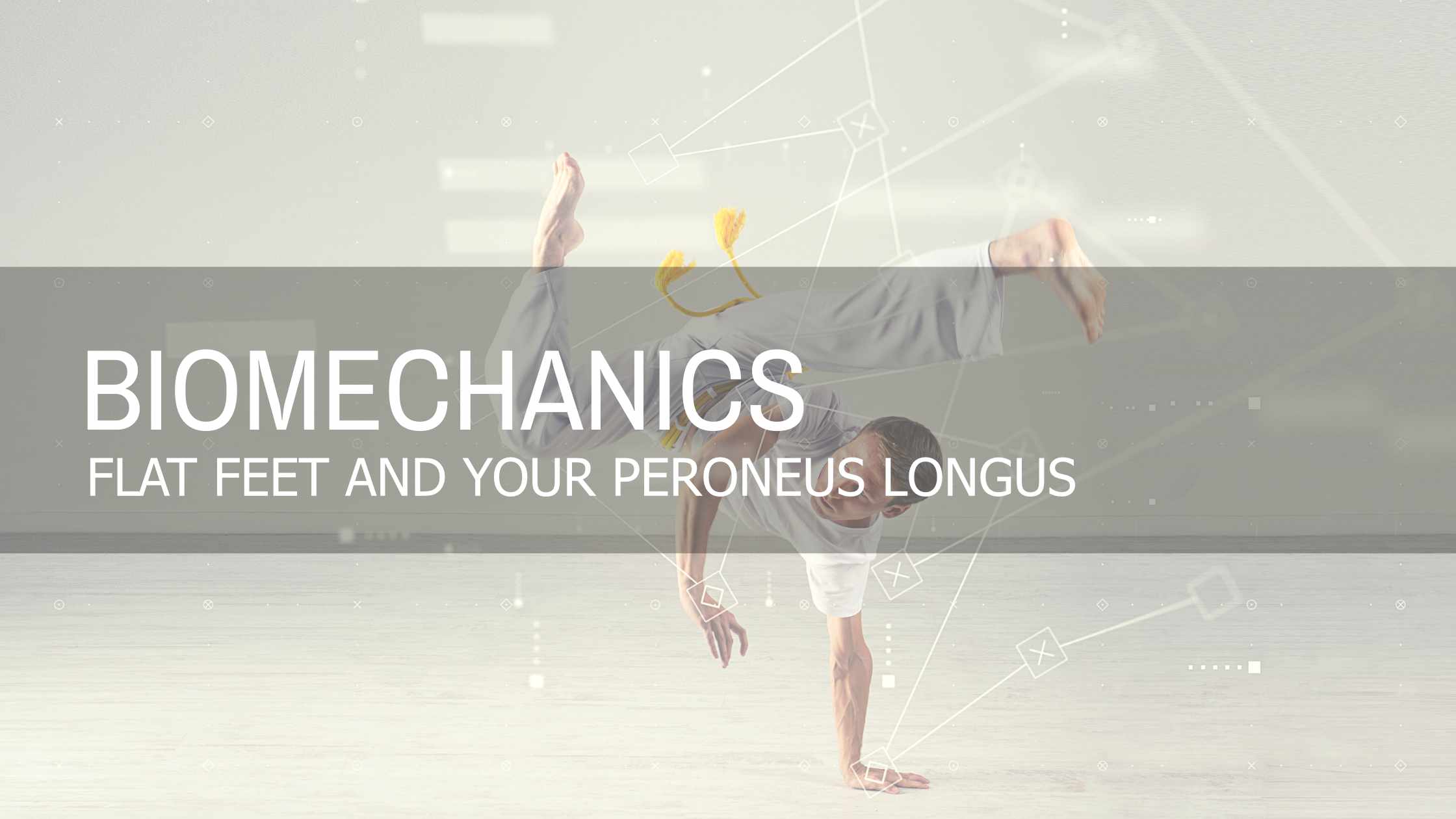
Sep 13 , 2021
0 Comments
Designed to Move | Flat Feet and Your Peroneus Longus
The average person walks roughly 115,000 miles, in their lifetime. That’s enough to circumference the earth four times. That’s a lot of walking!
You might be interested to know that if you are walking normally, your whole foot is never flat on the ground. That’s an important piece of information to understand if you want all those miles to be pain free.
How Would You Know?
Walk across the beach and examine your footprint in the sand. You’ll see that the inside border closest to the big toe comes in contact with the ground. (a.k.a. FLAT) If that’s going on, you’ll want to pay close attention to what comes next.
How Are We Supposed to Walk?
If your feet are well-aligned, your toes will point straight ahead as you walk. With every step, your heel should be the first point of contact, then the outside border of your foot, then the ball of your foot, and finally the big toe. These are the mechanics of foot strike.
The 52 bones, 33 joints, 107 ligaments, and 19 muscles and tendons hold the feet together and allow them to move and absorb forces exerted from the ground. The foot serves as the frontline in intercepting forces before they are transmitted into the leg and the rest of the body.
As you place weight into your foot during your midstance phase of walking, the bones of the foot will naturally flatten out a bit to absorb the forces. The ligaments, tendons and musculature should act to minimize this “spread”.
Flat Feet
Some of the most common foot problems involve corns and calluses. These are never normal even though they are common. They indicate that the alignment of the foot is off and that extra wear and tear is going on with one of its structures. This is typically associated with excess “spread” or flattening of the foot due to muscular imbalances.
It is important to note, however, that genetic makeup can play into the bone structure of the feet and contribute to these issues as well.
Your Arches
When you’re born, you start out with flat feet. Your arch (the one you usually associate with with your foot) doesn’t develop until you strengthen the muscles which form it. This happens as you begin to walk. Once your arch develops it provides structure, absorbs shock, transfers force and springs you forward.
While there are three arches to the foot, the one that plays the most significant role, is the medial arch. This arch runs from the heel to the big toe and relies heavily on the muscles and plantar fascia to maintain its form.
The plantar fascia is the flat band of tissue that connects your heel to your toes. Many of you with foot pain may already be familiar with this ligament. Strained plantar fascia can lead to plantar fasciitis. A condition where the fascia becomes inflamed, swollen, and irritated.
Functionally, you can see the plantar fascia as a continuation of the posterior calf muscles and Achilles tendon on the backside of the lower leg. The Achilles tendon attaches to the heel and blends into the plantar fascia. They all act together to support the arch from collapsing under the weight of the body. They also functionally act to point the toe downward towards the ground. (plantar flexion)
The Foot Sling
In addition to the posterior calf muscles (Soleus, Gastrocnemius), there are three other muscles that descend down from the lower leg which contribute support for the medial arch. These include the tibialis anterior/posterior and the peroneus longus. The tibialis anterior and peroneus longus make a lasso, or sling, around the foot that essentially controls the medial arch.
The peroneus longus attaches from the fibula and descends down the lateral side of the leg and behind the outside ankle to attach under the foot. This is where the tibialis anterior meets up with the tendon of the peroneus. It ascends around the inside portion of the foot back across the ankle to attach to the lateral side of the tibia. Like the helix of a DNA strand, it creates a lasso that supports the medial arch.
The Problem
You’ll notice that your typical shoe has some sort of arch support built into it. There is a cushioning or brace in the middle of the shoe to support the medial arch. This makes the muscles tasked with typically supporting this function very weak. These include the tibialis anterior and posterior. When these muscles lose their strength and supportive tension, this can lead to a movement distortion where the foot will excessively flatten out when walking or standing. This is called excess pronation. This is because these muscles act to pull the arch upward and stabilize the foot. This causes the ankle to rotate internally placing a greater amount of stress on the supporting structures like the plantar fascia, achilles and especially posterior calf muscles. Since these muscles are responsible for flexing the toes down (plantar flexion), their overuse makes them adaptively tight and shortened essentially placing the foot, and the body, for the matter, on a continual slope.
This reduces the ability of the ankle to bend (dorsiflex). This limited mobility reinforces the flattening and turning out of the foot. A Global Body Issue
By extension, in seemingly unrelated areas of the body, issues can develop which can be traced back to problems with the alignment of your feet. This can include lower back pain, headaches, misalignment in the spine, and even digestive issues. This is because our feet constantly supply the brain with information about the ground we are walking on. This happens through the nervous system. In fact, there are more nerve endings per square centimeter in the foot than any other part of the body.
If the alignment of the foot is off, the nervous system will interpret the information and seek to create a compensation strategy for the imbalance. This usually includes a deviation from the optimal muscular recruitment strategy for the stabilization of the joints above the foot. This domino effect can lead to extra wear and tear on the body, and, ultimately, injuries.
Yes, There is a Solution!
- Increase the mobility of the muscles that contribute to excess pronation (such as the peroneus longus and calf muscles).
- Recognize which muscles are responsible for proper ankle and foot stability and strengthen them (such as the tibialis anterior/posterior).
- Condition your nervous system with functional movement patterns that coordinate the appropriate muscular firing patterns. (You’ll get an example in the video below so read on!)
- Reduce movements redundancies that require foot and ankle control until adequate strength can be maintained (i.e., running, stair climbers, etc.).
- Consider wearing lower profile or minimalist shoes with reduced arch support (a good idea would be to alternate your traditional athletic shoes with the minimalist so you can ease into it - also avoid endurance based/cardio exercising with the minimalist shoes until adequate ankle stability can be maintained)
How to Assess?
Want to find out if you have excess pronation? Here is a quick movement assessment you can complete to determine if you exhibit the signs:
In front of a mirror and without your shoes on, stand with your feet shoulders-width apart and pointed straight ahead. Raise your arms overhead with the elbows fully extended. The upper arm should be right in line with the ears. Squat down to roughly the height of a chair without letting the arms fall; then go back to the beginning position. Repeat several times.
- Did either of your feet flatten or rotate outward?
- Did either of your heels lift off the ground?
- Did either of your knees rotate inward?
If you answered yes to any of these questions, you tested positive for this common posture problem and you’ll want to pay attention to what comes next and watch the accompanying video on how to correct it.
Simple Corrective Methods
Correcting Overactive Muscles
Because we move in patterns, our bodies favor the use of certain muscle groups over others. Since many of us have a tendency towards excessive pronation of the feet, this can place the peroneus longus muscles into an overactive position. You’ll want to lengthen them via self-myofascial release, and then follow the myofascial release with neuromuscular stretching.
Below are the muscles you’ll want to focus on for excessive foot pronation this week:
- Peroneus longus Self Myofascial Release for 60 to 90 seconds on each side
- Stretch or lengthen each for 60 to 90 seconds on each side
Correcting Underactive Muscles
As mentioned above, pain in the body is commonly caused when how we move forces certain muscles to work overtime, while other muscles become lazy and don’t want to function. You’ll need to wake up these lazy muscles through isolated strength movements.
The tibialis anterior and posterior are the muscles we’ll want to engage this week:
- Tibialis anterior | Sitting band dorsiflexion with inversion
- Posterior chain | Single leg balance
- Tibialis anterior and posterior | Seated dumbbell feet lift 2 sets on each muscle group 10-15 reps using a slow opening of the muscle, isolated hold at the bottom of the movement, followed by a controlled shortening of the muscle.
Now that you know which muscles are typically underactive and overactive, let’s put it all together for you. Watch the video for a step-by-step breakdown on how to target each of these areas. Before you get started, make sure you have a foam core ball, a heavy exercise band and a light dumbbell available.
Start off by applying the techniques three times a week and build from there. Every so often, reassess your posture and see how far you’ve progressed. Soon, you’ll start to see noticeable changes in your body position and mobility!




